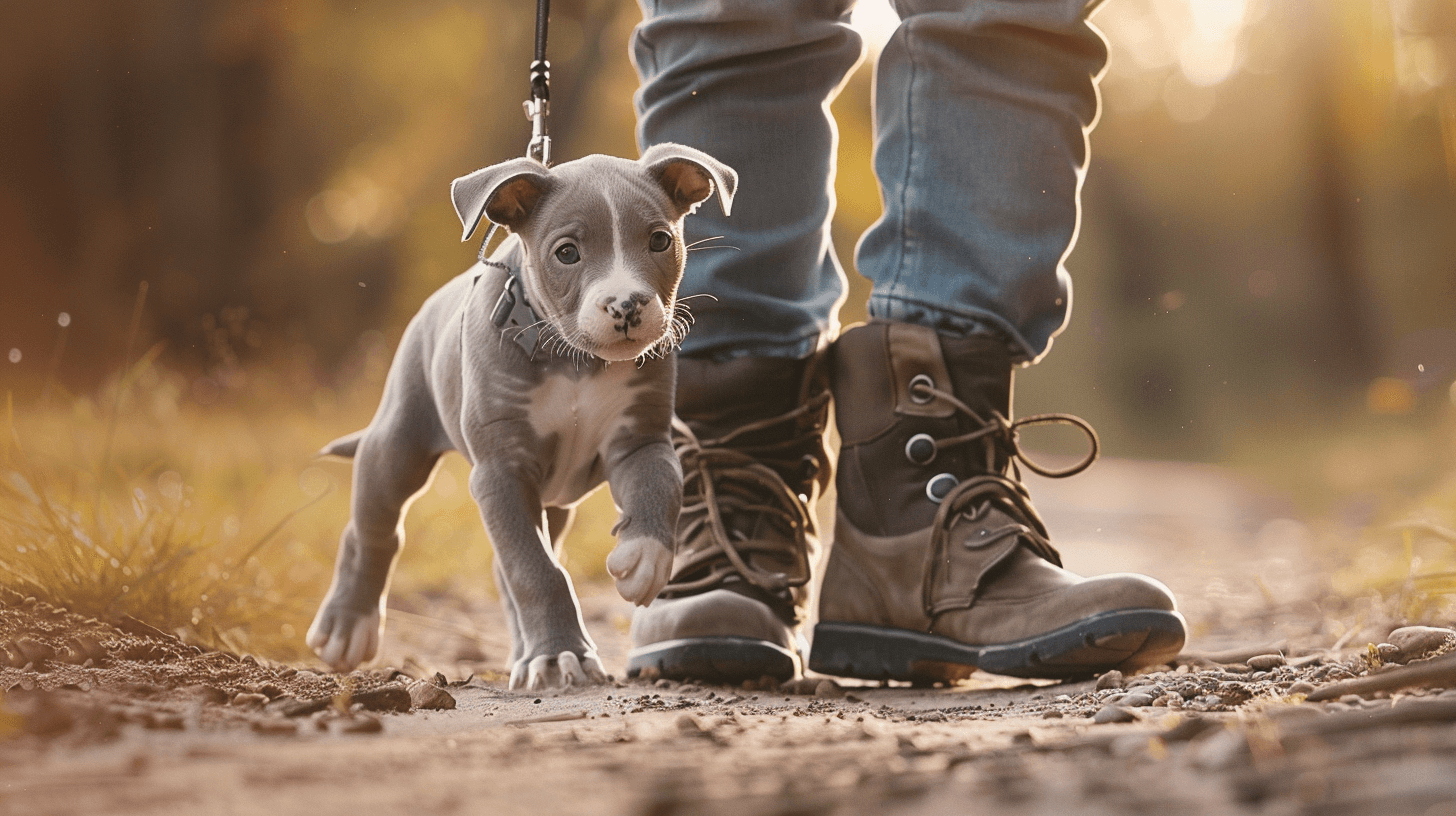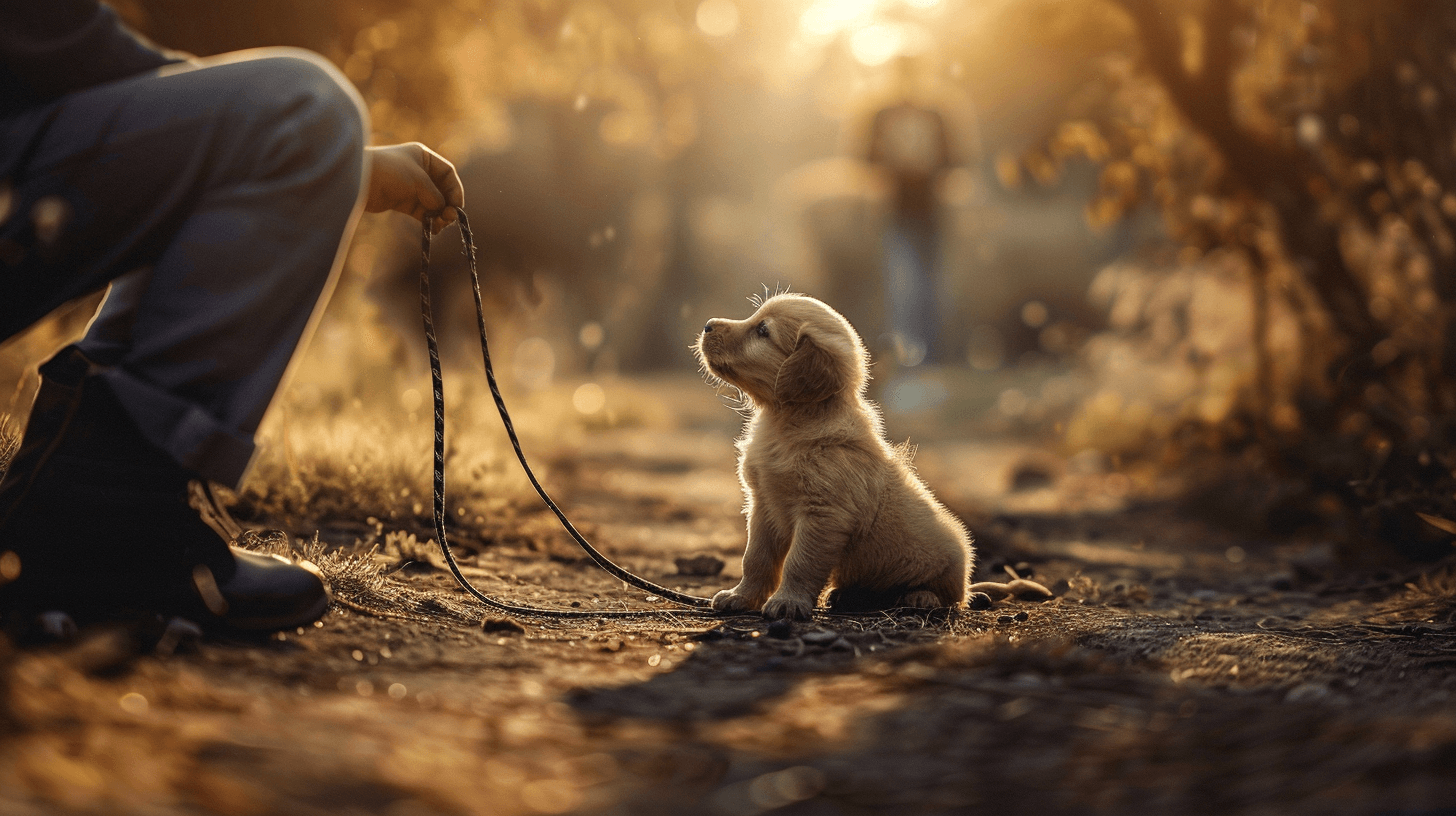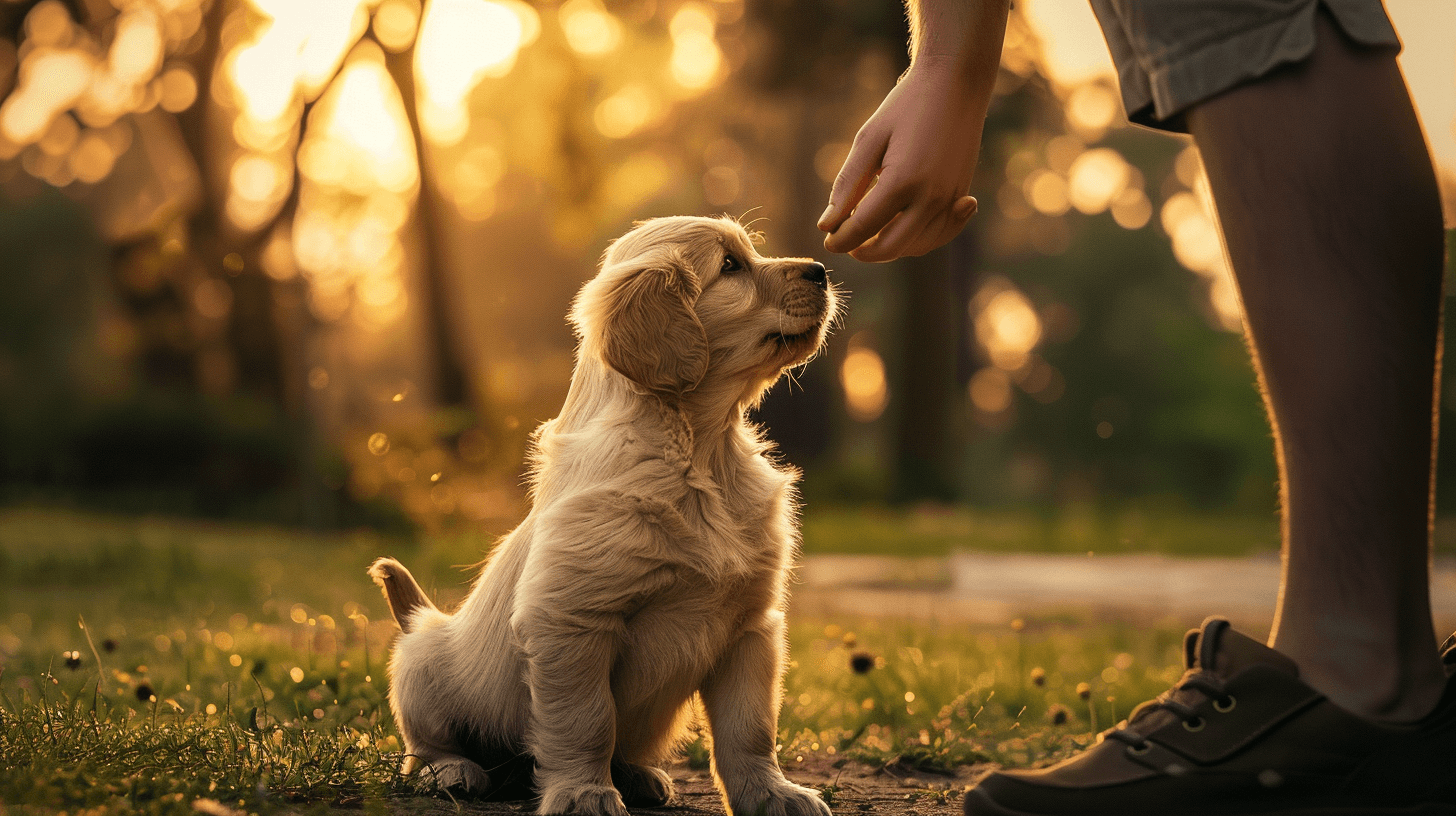As a devoted dog lover and an ever-busy individual, I know firsthand the challenges that come with raising and training a puppy amidst a packed schedule. It’s like trying to juggle while learning to balance—a test of patience, timing, and dedication. But here’s the good news: innovative puppy training techniques have revolutionized how we approach teaching our furry friends, making it more accessible and effective for those of us constantly on the move.
The joy of coming home to a wagging tail is unmatched, yet the path to a well-behaved pup requires more than just love and good intentions. It demands smart strategies that fit into our hectic lives without compromising the quality of training. That’s where the essence of easy dog training, quick training methods, and obedience training at home comes into play, tailored specifically for the busy owner’s guide to puppy training.
We’ll explore a variety of innovative puppy training techniques that not only promise to be time-efficient but also incredibly effective. From crafting a flexible puppy training schedule to utilizing quick puppy training methods that blend seamlessly into daily routines, we’re here to ensure your journey towards effective puppy training is as smooth and rewarding as possible.
Whether you have minutes to spare or can dedicate longer sessions sporadically, the goal is clear: to nurture a well-mannered canine companion through training puppies at home, despite the ticking clock.
So, buckle up and prepare to embark on this exciting journey. Together, we’ll discover that being a busy owner doesn’t mean compromising on the quality of your puppy’s upbringing. With the right approach, innovative puppy training doesn’t just become possible; it becomes a joyful part of your everyday life.
Contents
- 1 Understanding Puppy Training Fundamentals
- 2 Creating a Puppy Training Schedule for Busy Owners
- 3 Innovative Puppy Training Techniques
- 4 Easy Dog Training Tips for Busy Lifestyles
- 5 Ensuring Success with Obedience Training at Home
- 6 Conclusion: The Busy Owner’s Guide to Effective Puppy Training
- 7 Let’s Chat
- 8 Resources
Understanding Puppy Training Fundamentals

Embarking on the journey of puppy training is much like starting a new adventure with a curious, energetic, and sometimes unpredictable companion. It’s an adventure that requires patience, consistency, and a sprinkle of creativity. Before we dive into the specific techniques that will save you time and keep your pup engaged, it’s crucial to grasp the fundamentals of effective puppy training. These foundations are not just about commands and cues; they’re about building a relationship of trust and understanding with your furry friend.
Consistency is Key: The golden rule of puppy training is consistency. Puppies thrive on routine and predictability. Whether it’s their feeding schedule, potty breaks, or training sessions, maintaining a consistent routine is crucial for their learning and development. This consistency helps in establishing a sense of security and trust, making the training process smoother for both of you.
Positive Reinforcement Works Wonders: At the heart of easy obedience techniques is positive reinforcement. Rewarding your puppy for good behavior with treats, praise, or playtime encourages them to repeat those behaviors. This approach not only strengthens your bond but also makes the learning process enjoyable for your pup, ensuring they associate training with positive experiences.
Understanding Your Puppy’s Needs: Each puppy is unique, with their own personality and learning pace. Some may excel in quick training methods, while others need a bit more patience and repetition. Tuning into your puppy’s needs and adjusting your training methods accordingly is essential for effective puppy training. Observing their reactions and being responsive to their comfort levels will guide you in choosing the right pace and techniques.
Building a Strong Foundation with Obedience Training at Home: Obedience training at home lays the groundwork for a well-behaved dog. Basic commands like sit, stay, come, and down are not just tricks; they are essential for your puppy’s safety and socialization. Integrating these commands into daily routines helps reinforce their learning and ensures they respond reliably, even in distracting environments.
By embracing these fundamentals, you’re setting the stage for a rewarding training experience that fits into your busy lifestyle. Remember, the goal of puppy training is not just about teaching commands; it’s about nurturing a well-adjusted, happy dog who is as much a part of your family as any human member.
Creating a Puppy Training Schedule for Busy Owners

For the busy dog owner, every minute counts. Yet, the thought of adding puppy training into an already jam-packed schedule can seem daunting. Fear not, for the key lies in crafting a training schedule that’s as flexible as it is effective. Here’s how you can make puppy training work for you, not against you, ensuring your pup gets the learning experience they need without overwhelming your calendar.
Maximize Short Training Sessions: One of the most innovative puppy training techniques for the time-strapped owner is to capitalize on short, focused training sessions. Even five to ten minutes of training, a few times a day, can have a significant impact. These sessions can fit into morning routines, lunch breaks, or even while waiting for your dinner to cook. Quick dog training tips, such as teaching a single command or reinforcing a desired behavior, can be incredibly productive when done consistently.
Incorporate Training into Daily Activities: Training puppies at home doesn’t have to mean setting aside separate times exclusively for training. Merge training sessions with daily activities. For instance, practice ‘sit’ and ‘stay’ commands before meals, or work on ‘come’ when calling them inside from the yard. This method not only saves time but also helps your puppy learn to follow commands amidst various distractions.
Utilize Technology and Resources: In today’s digital age, busy owners can benefit from a plethora of online resources and tools designed to facilitate easy dog training. From mobile apps that offer training games and tips to online courses that guide you through the basics of obedience training at home, these resources can be a godsend for optimizing your training schedule.
Be Consistent with Commands and Cues: Consistency remains crucial, even when time is scarce. Using the same commands, cues, and rewards helps your puppy understand and learn behaviors more quickly. This consistency across short and integrated training sessions accelerates learning and reinforces desired behaviors, making the most of the limited time you have.
Plan Ahead for Success: A well-thought-out puppy training schedule includes not only daily training times but also goals for what you want to achieve each week. Setting clear, achievable objectives for training puppies with limited time helps track progress and keeps you both focused and motivated.
Seek Support When Needed: Remember, you’re not alone in this journey. Busy lifestyles can benefit from seeking support, whether it’s a family member who can help reinforce training or a professional trainer for more structured sessions. Sharing the responsibility can enhance the training experience for your puppy while ensuring you don’t feel overwhelmed.
Innovative Puppy Training Techniques

In the world of puppy training, innovation is key, especially for busy owners seeking to make every moment count. Here, we introduce a variety of unique training methods designed to fit into your lifestyle, ensuring your puppy receives top-notch training without requiring you to rearrange your entire schedule.
Leverage Playtime for Learning: One of the most enjoyable and effective training methods involves incorporating learning into playtime. Use toys and games to teach commands like ‘drop it,’ ‘fetch,’ and ‘come.’ This approach not only keeps training sessions lively and fun but also helps your puppy learn important commands in a relaxed setting.
Use Meal Times as Training Opportunities: Meal times offer a fantastic opportunity for training. Asking your puppy to ‘sit’ or ‘stay’ before placing their food down reinforces good manners and patience. This method integrates training seamlessly into daily routines, making it an efficient way to teach discipline and obedience.
Incorporate Training into Walks: Walks are not just for exercise; they’re an excellent time for training too. Practice commands like ‘heel,’ ‘stop,’ and ‘sit’ during walks. This not only improves your puppy’s leash manners but also exposes them to various distractions, teaching them to follow commands in different environments.
Smart Toys and Training Apps: Technology can be a great ally in training puppies at home. Interactive toys that reward puppies for solving puzzles or apps that guide you through training exercises can complement your training regimen. These tools are especially useful for keeping your puppy engaged and learning, even when you’re not actively training them.
Short and Sweet Training Sessions: Emphasize the importance of keeping training sessions short but productive. Puppies have short attention spans, so sessions of 5-10 minutes can be more effective than longer ones. This approach fits well into a busy schedule, allowing for multiple brief sessions throughout the day.
Positive Reinforcement and Instant Rewards: Immediate rewards for good behavior are crucial in puppy training. Use treats, praise, or play to reinforce good behavior on the spot. This positive reinforcement encourages your puppy to repeat those behaviors, making training a positive experience for them.
Record and Review: Consider recording your training sessions. Watching them back can provide insights into what’s working and what isn’t, allowing you to adjust your techniques accordingly. This reflection can be incredibly valuable in refining your approach to training.
By adopting these innovative puppy training techniques, you can ensure that your puppy’s training is not only effective but also adaptable to your busy lifestyle. Each method is designed to maximize engagement and learning within the constraints of limited time, proving that quality training is achievable, no matter how packed your schedule might be.
Easy Dog Training Tips for Busy Lifestyles

Training your puppy doesn’t have to be a daunting task reserved for those with ample free time. Even the busiest of owners can find success with the right strategies. Here are some easy dog training tips that cater to your hectic lifestyle, ensuring your puppy learns effectively without requiring hours of dedicated time.
1. Utilize Routine Activities for Training: Every interaction with your puppy is an opportunity for training. Simple actions like asking your puppy to sit before going out or practicing ‘stay’ before feeding can reinforce good habits. This approach turns routine activities into valuable training sessions, seamlessly integrating learning into your daily life.
2. Focus on One Command at a Time: Instead of overwhelming yourself and your puppy by trying to teach multiple commands at once, focus on one command until it’s mastered. This not only simplifies training but also ensures your puppy fully grasps each command, making for more effective learning.
3. Keep Training Positive and Fun: Puppies learn best in a positive, stress-free environment. Keep training sessions light and fun, using plenty of praise and rewards. This positive reinforcement makes learning a joy for your puppy and keeps you both looking forward to training sessions.
4. Be Consistent with Commands and Cues: Consistency is crucial in dog training. Use the same words and signals for commands every time. This clarity helps your puppy understand what’s expected, leading to quicker learning. Consistent routines and responses from all family members can greatly enhance your puppy’s training progress.
5. Invest in Training Tools and Resources: From treat-dispensing toys that encourage problem-solving to clickers for positive reinforcement, a variety of tools can make training easier and more engaging for your puppy. Additionally, consider online resources or books for quick training methods that can guide your approach, offering new ideas to keep training fresh and effective.
6. Make the Most of Short Sessions: Short, frequent training sessions are more effective than occasional lengthy ones, especially for puppies with short attention spans. Integrating brief, focused training moments into your day can lead to significant progress over time, fitting easily into a busy schedule.
7. Celebrate Small Victories: Every small step forward is a victory in puppy training. Celebrate these moments with your puppy, reinforcing the positive behavior and building a stronger bond. Recognizing these successes keeps you both motivated and highlights the progress you’re making, even on the busiest days.
By incorporating these easy dog training tips into your lifestyle, you can ensure that your puppy receives consistent, effective training without the need for extensive time commitments. These strategies are designed to fit into the nooks and crannies of a busy schedule, proving that successful dog training is about quality and strategy, not just time spent.
Ensuring Success with Obedience Training at Home

Obedience training is the cornerstone of a well-behaved dog, laying the groundwork for a harmonious household. For the busy owner, making obedience training at home both effective and efficient is key. Here are strategies to ensure success, even when time is a precious commodity.
Create a Distraction-Free Environment: Begin training sessions in a quiet area of your home where your puppy can focus without distractions. As they become more proficient, gradually introduce distractions to strengthen their obedience in various situations. This controlled approach allows you to make the most of your training time by focusing on quality over quantity.
Use High-Value Rewards: Identify what motivates your puppy the most—be it treats, praise, or playtime—and use these as rewards during training sessions. High-value rewards make the learning process more engaging for your puppy and can encourage quicker learning of new commands.
Establish Clear Communication: Clear, consistent commands are the foundation of effective obedience training. Ensure that everyone in your household uses the same words and gestures for commands to avoid confusing your puppy. This consistency helps accelerate their learning process.
Incorporate Training into Daily Routines: Obedience training doesn’t have to be a separate part of your day. Incorporate commands like ‘sit,’ ‘stay,’ and ‘come’ into daily routines, such as meal times, walks, and playtime. This not only reinforces training but also helps your puppy understand that obedience is part of everyday life.
Prioritize Key Commands: Focus on teaching essential commands that will have the most significant impact on your puppy’s behavior and safety, such as ‘sit,’ ‘stay,’ ‘come,’ and ‘leave it.’ Mastering these commands can make a big difference in managing your puppy’s behavior and ensuring their safety.
Stay Patient and Positive: Remember, every puppy learns at their own pace. Maintain a positive attitude and be patient with your puppy’s progress. Celebrating small successes can motivate both you and your puppy to continue working together towards your training goals.
Seek Professional Guidance if Needed: If you’re struggling with certain aspects of obedience training or simply want to ensure you’re on the right track, don’t hesitate to seek help from a professional dog trainer. Many trainers offer online consultations or in-home visits that can be tailored to your busy schedule.
By following these strategies, you can make obedience training at home a successful and rewarding experience for both you and your puppy. Effective training lays the foundation for a lifetime of companionship and mutual respect, ensuring that your puppy grows into a well-mannered and obedient dog.
Conclusion: The Busy Owner’s Guide to Effective Puppy Training

Embarking on the journey of puppy training as a busy owner can seem like a daunting task at first glance. However, as we’ve explored throughout this guide, innovative techniques and strategic planning can make the process not only manageable but also enjoyable for both you and your puppy. By embracing the principles of effective puppy training, integrating learning into your daily routines, and utilizing quick, innovative methods, you can foster a strong, obedient, and loving relationship with your puppy.
Remember, the essence of training lies not in the quantity of time spent but in the quality of the interactions and consistency of the message. Short, focused training sessions, positive reinforcement, and incorporating training into daily activities are key strategies that can lead to significant progress. Moreover, understanding that every puppy is unique and adapting your approach to fit their individual needs will make the training process more effective and rewarding.
As you move forward, keep in mind that patience, consistency, and a positive attitude are your best tools. Celebrate the small victories along the way, and don’t hesitate to seek support from the community or professionals when needed. Training your puppy is a journey that lays the foundation for a lifelong friendship, and every effort you make is a step towards a well-behaved and happy companion.
Let’s Chat
We invite you to share your own experiences, challenges, and successes in puppy training. Join the conversation with fellow busy owners and exchange quick dog training tips, innovative techniques, and motivational stories. Together, we can support each other in raising well-trained, obedient, and joyful dogs, even amidst our busy lives.
Remember, the journey of puppy training is one filled with love, laughter, and learning. Embrace it fully, and watch as your furry friend grows into the loyal and well-behaved companion you’ve always dreamed of.
Resources


